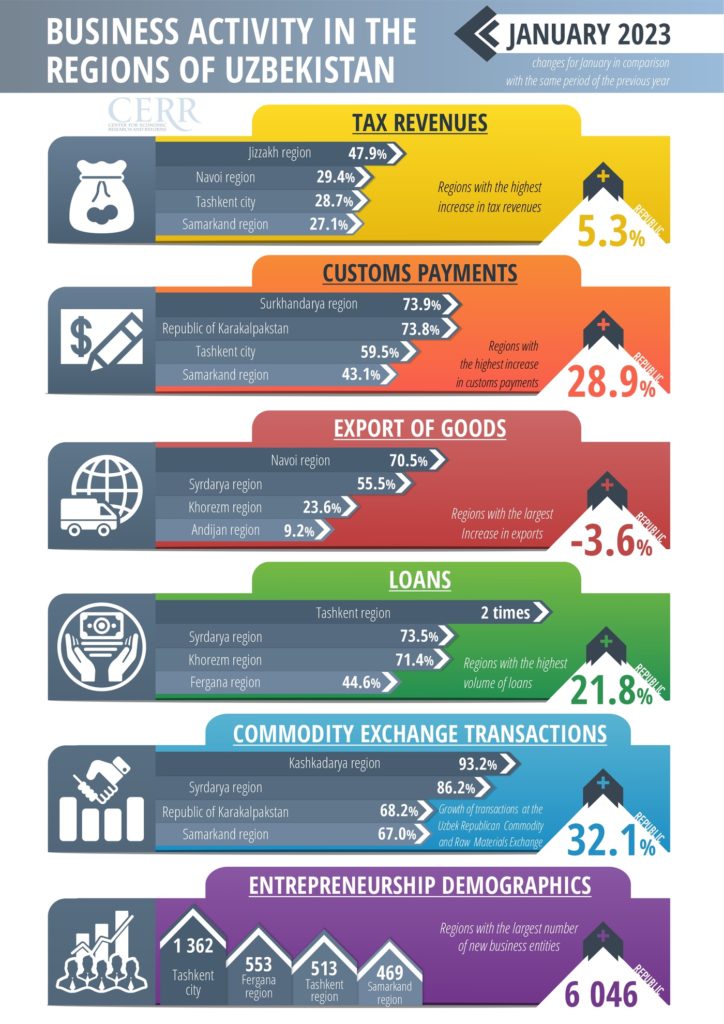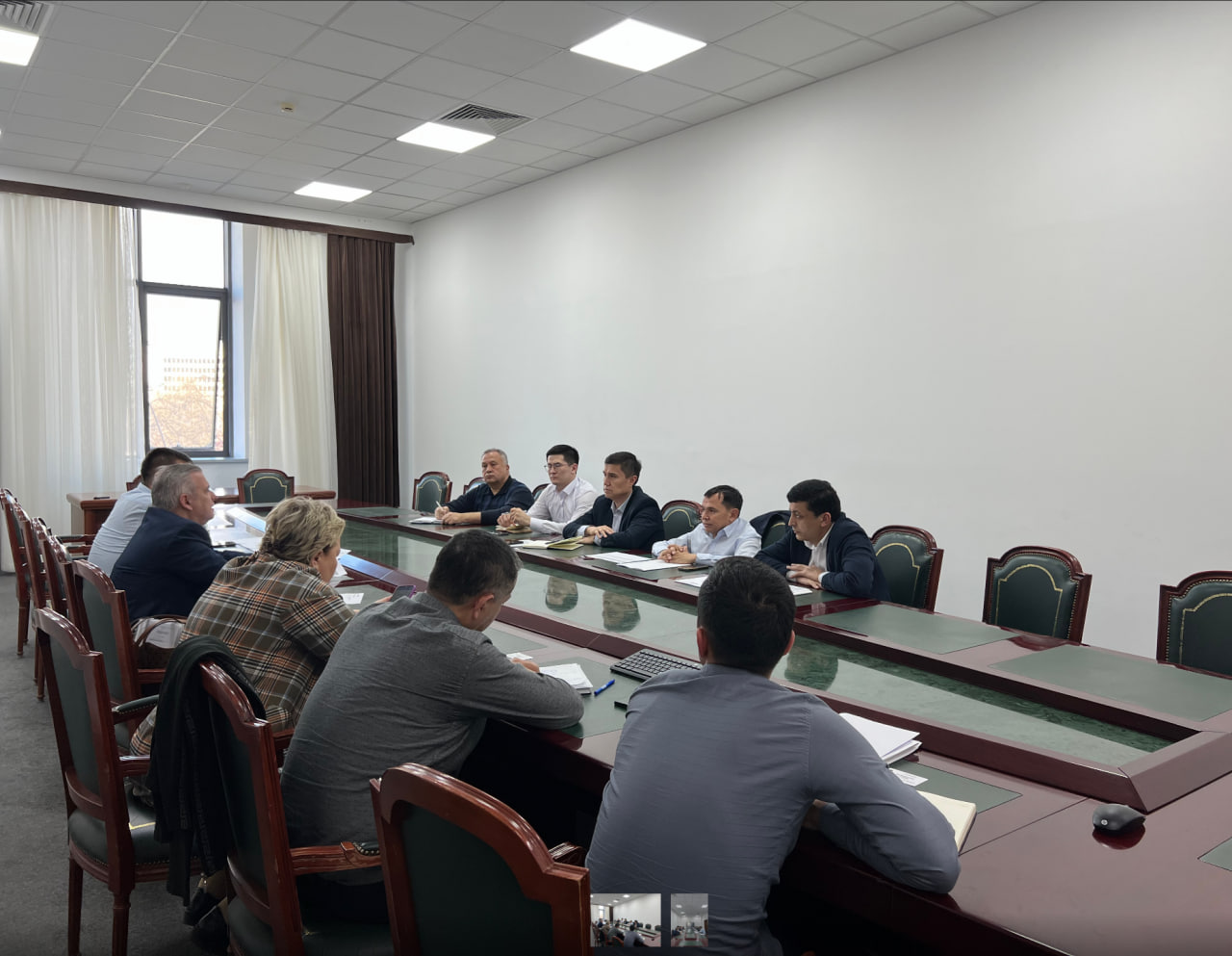Which regions of Uzbekistan have shown the greatest business activity since the beginning of the year (+infographics)
Analysis of business activity is calculated monthly by CERR based on operational data. According to CERR estimates, tax receipts increased moderately, despite the reduction in the VAT rate in the country from 15% to 12% from January 1, 2023, and the weather crisis (interruptions in the supply of electricity and natural gas to production facilities due to abnormal weather conditions in mid-January).
To assess the economical situation in the country, the Center for Economic Research and Reforms conducts a monthly assessment of the state of business activity at the regional and district levels. The analysis is carried out based on operational data of the State Customs Committee, the State Tax Committee, the Central Bank and the UzEx.
The monitoring results showed that the volume of tax revenues of the republic in January this year increased by 5.3% compared to the same period last year.
At the same time, a significant increase in tax revenues were recorded in the Jizzakh (by 47.9), Navoi (by 29.4%), Samarkand (by 27.1), Andijan (by 19.0%) and Tashkent (by 18.6%) regions, in the Republic of Karakalpakstan (by 19.7%) and in Tashkent (by 28.7%).
According to the analysis, tax receipts increased moderately, despite the reduction in the VAT rate in the country from 15% to 12% from January 1, 2023 and the weather crisis (interruptions in the supply of electricity and natural gas to production facilities due to abnormal weather conditions in mid-January).
In addition, in terms of sources of tax receipts, VAT increased by 20%, and income tax receipts by 15%, property tax by 37%, land tax by 38%, which allowed to maintain a moderate increase in the level until the end of the month.
Receipts on customs payments for the analyzed period increased by 28.9% compared to the same period in 2022. The largest increase in customs receipts was observed in Surkhandarya (by 73.9%), Samarkand (by 43.1%), Tashkent (by 34.2%), Namangan (by 34.0%), and Ferghana (by 10.9%) regions, and in the Republic of Karakalpakstan (by 73.8%) and Tashkent (by 59.5%).
The main factors that influenced the increase in revenue from customs duties were the increase in imports in January 2023 by 42.3% compared to the same period of the previous year.
According to the State Customs Committee, the volume of exports of goods from the beginning of this year to January 31 decreased by 3.6% compared to the same period last year. Exports decreased in Surkhandarya (by 40.1%), Bukhara (by 27.8%), Jizzakh (by 19.3%), Fergana (by 19.0%), Tashkent (by 17.8%), Namangan (by 9.8%) and Samarkand (by 9.3%) regions, and in the Republic of Karakalpakstan (by 41.2%).
The decline in exports in Surkhandarya region is due to a reduction in exports of yarn and textile products; in Bukhara region — the direction of cotton fibre to the domestic market; in Jizzakh, Ferghana and Namangan regions — a reduction in yarn exports; in Tashkent region — a reduction in exports of metals and products made from them, in Samarkand region — a reduction in exports of fruit and vegetable products, and the Republic of Karakalpakstan — a reduction in the export of plastics and yarn.
Export growth was observed in Navoi (by 70.5%), Syrdarya (by 55.5%), Khorezm (by 23.6%), Andijan (by 9.2%) and Kashkadarya (by 7.6%) regions, and in Tashkent (by 5.7%).
The growing growth rates of exports of food products, industrial goods, chemicals and agri-food products explain the increase in Uzbekistan’s exports.
The volume of loans issued by commercial banks in the period from January 1 to January 31 this year increased by 21.8% compared to the same period last year.
A significant increase in the issuance of loans was noted in Tashkent (by 102.3%), Syrdarya (by 73.5%), Khorezm (by 71.4%), Ferghana (by 44.6%) regions, in the Republic of Karakalpakstan (by 17.8%) and Tashkent (by 32.7%).
The volume of transactions on the UzEx for the analyzed period increased by 32.1%. A significant increase in exchange activity is observed in Kashkadarya (by 93.2%), Syrdarya (by 86.2%), Samarkand (by 67.0%), Khorezm (by 62.8%) regions, and in the Republic of Karakalpakstan (by 68.2%) and Tashkent (by 28.5%).
The growth in the volume of transactions in these regions is ensured by increasing the sale of such goods as liquefied gas, mineral fertilizers, technical seeds, automobile gasoline, diesel fuel, construction and household materials, wheat flour, wheat, sugar, cotton fiber, rolled ferrous and non-ferrous metals, polyethylene, etc.
During the analyzed period, 6,046 new economic entities were created, the largest number of which were registered in Fergana (553), Tashkent (513), Samarkand (469), Khorezm (453), Bukhara (402) regions and in Tashkent (1,362).

Source: review.uz
Другие новости и события
Any use (reproduction, publication, copying, reprinting, distribution, translation, broadcasting, processing and other methods of distribution) of the materials of the Investment Portal - Invest.gov.uz, without indicating the original source and a link to the Portal is strictly prohibited!








